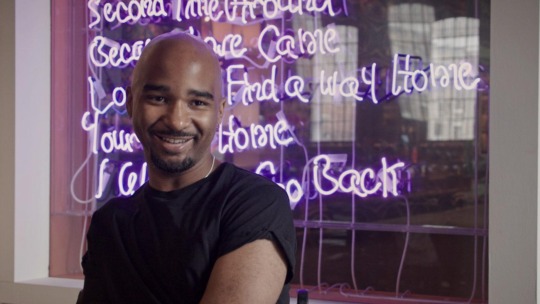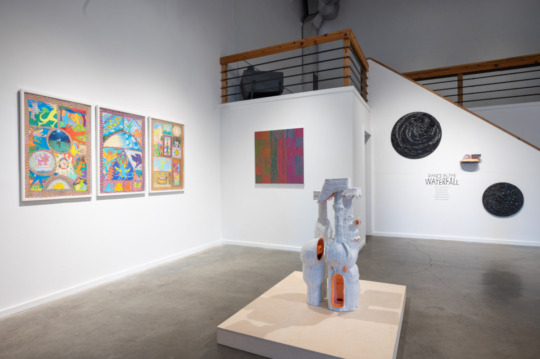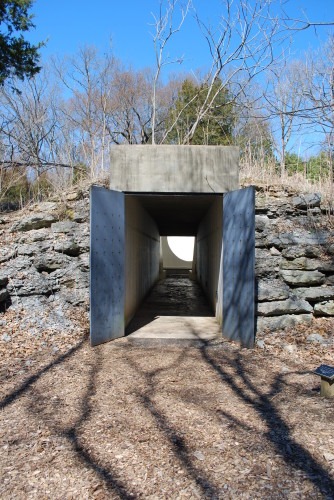
When I first discovered James Turrell’s Blue Pesher sculpture on Cheekwood’s Sculpture Trail, I didn’t even know I was on a “sculpture trail” or inside a work of art. This was 1999, when my interest in art hadn’t developed much past an obedient appreciation for masterworks by Bruegel. One angst-ridden day, I had walked along the overgrown trail in the forest fringe of the museum’s grounds until I found a set of open steel double doors. Seeing that it led into a cavelike hallway, I entered and followed the light to the end of the 30-foot tunnel. There was an annular meeting room with a circle cut out of the ceiling, which the sun shone through. The bench along the concave walls surrounded a shallow circular pit of black sand. I thought, Either this is where a cult meets or where UFOs dock. Until moving away from Nashville in 2001, I visited the room fairly frequently and, consequently, became interested in meditation.
On a return trip, I was disappointed to learn that James Turrell, the man behind the room, was a famous artist on a spiritual mission with his art. The fact that I had something of a profound spiritual experience in Blue Pesher made me want to keep a distance from the sculpture. This may sound contradictory since he accomplished what he apparently intended, but I struggle with art that aims to transform the viewer in a specific way. I felt like I had been tricked. I preferred the former view that this room had been a forgotten museum project or a place where a secret society used to meet.
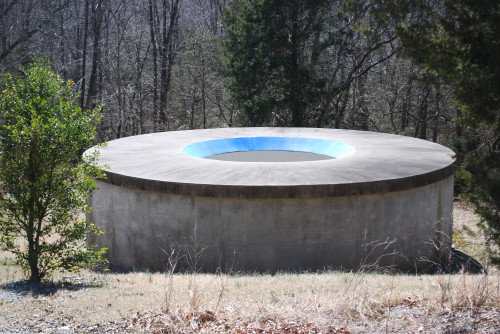
In his book The Accidental Masterpiece: On the Art of Life and Vice Versa, New York Times art critic Michael Kimmelman writes that Turrell is a lapsed Quaker who orients his practice around light. In 1977, Dia Art Foundation offered funding for him to buy Roden Crater north of Flagstaff Arizona to establish his most ambitious, still unfinished art installation. The volcanic crater, arguably the largest work of Earth art ever produced, consists of a network of tunnels and rooms similar to the one I found in the patch of Nashville forest. Offering a space where viewers can interact with the heavens, Turrell claims that his art is more about “your seeing than it is about my seeing, although it is a product of my seeing.” I have not seen Roden Crater yet, but I did visit his major, much-hyped Guggenheim Museum exhibition in the summer of 2013, and that was, in short, an epic disappointment.
I am living in Nashville again, and whenever I visit Blue Pesher it is empty. I take note of the fact that the black sand has been kicked out of its perfect circle. In the warmer months, the wasps are busy building nests on the walls. The echo effect always remains crisp. Occasionally, I sit up against the wall, approximately a foot from the section the sun is shining on. The sunshine turns into a clock hand and creeps over to me until I am fully cast in its light. After a minute, I get too hot and leave.
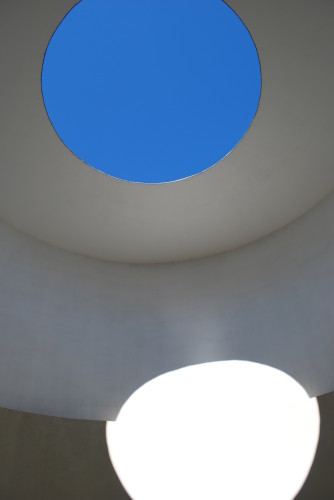
Permanent Residents: James Turrell in Nashville
Related Stories
Art21 x Burnaway
Reviews
Reviews
The Incredulity of Jacolby Satterwhite
In April's Art21 x Burnaway feature, we enter and explore the resurrection, rebirth, and regenerative quality of Jacolby Satterwhite's virtual worlds.
A Landscaped Longed For: The Garden as Disturbance at the Crisp-Ellert Art Museum, St. Augustine
Christopher Stephen reviews the visual metaphors of the garden found in A Landscape Longed For: The Garden as Disturbance at the Crisp-Ellert Art Museum, St. Augustine.
Dance in the waterfall at Red Arrow, Nashville
Margaret Jane Joffrion reviews the feeling montages and logic of colors found in Dance in the waterfall at Red Arrow, Nashville.


